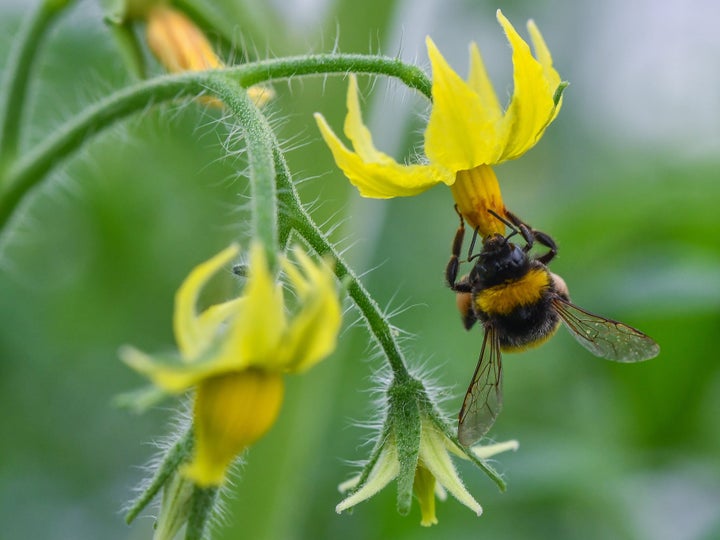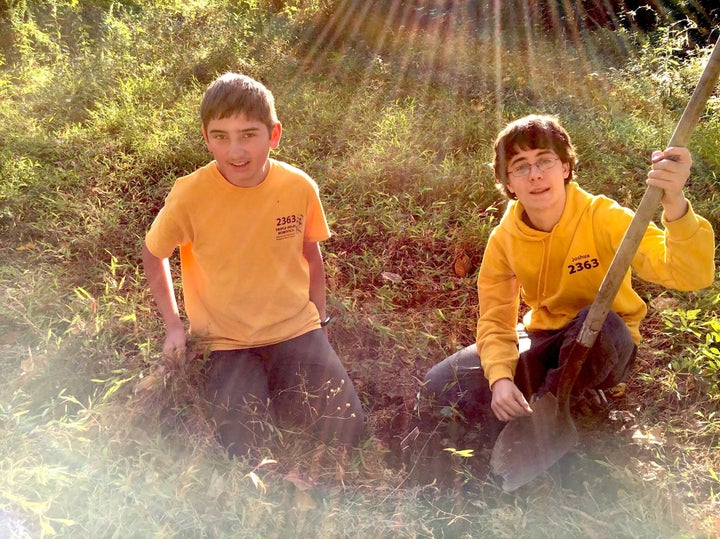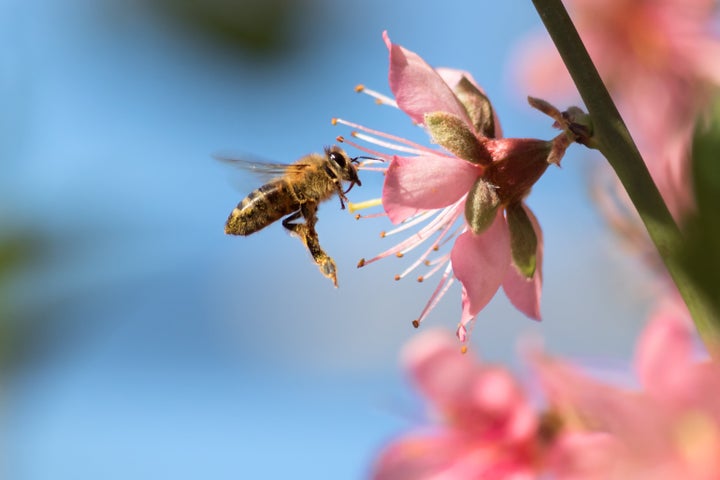In early March, before stay-at-home orders were issued in Virginia, 14-year-olds Luke Marston and Joshua Nichols hosted about 100 people at a garden party of sorts. But this was no ordinary backyard blowout. Attendees fanned out across 30 sites in the city of Newport News, including schoolyards, museum gardens and the edges of public parks, to plant flowers and shrubs — for bumblebees.
Pollinators are in trouble. By one estimate, some 40% of insect pollinators worldwide are at risk of extinction, especially bees and butterflies. One of the main drivers of their decline is the rampant destruction of their natural habitats.
It’s a problem Luke and Joshua are trying to help solve. The mass planting event was part of the teens’ plan to build a 13-mile stretch of pollinator habitats that they call the Bee Byway. Their homegrown effort is one of multiple projects taking place across the country to provide pollinating species with the plants they need to survive.
Pollinators are crucial for agriculture. Insects, birds and other species that carry pollen from plant to plant as they forage for food contribute to the production of more than a third of the crops grown and eaten around the world. Yet exposure to agricultural pesticides threatens the health of bees and other pollinators, and the expansion of massive farms that grow just one or two types of crops is replacing their native habitat and diminishing the plant biodiversity on which they depend.
Meanwhile, urban and suburban development are driving further habitat losses. About a million acres of land are take over by cities in the U.S. every year. Without food and shelter, and suffering health effects from pesticides, pollinators become easy pickings for dangerous parasites.
First lady Michelle Obama recognized the crisis in 2015 when she promoted the Million Pollinator Garden Challenge to encourage people across the country to plant for pollinators. The project reached its million-garden goal in just three years. “It was a monumental effort,” said Mary Phillips, senior program director at the National Wildlife Federation, who co-founded the project.

Not every garden is perfect for pollinators. Pollinator habitats typically comprise a variety of plants that are native to that particular part of the country. Most pollinators have evolved over thousands of years to have symbiotic relationships with specific plants, explained Mario Padilla, an entomologist researching bumblebees at the Butterfly Pavilion, a nonprofit insect zoo in Denver. Bumblebees, for example, have developed a unique method of grabbing onto the central part of a tomato flower and vibrating their bodies to dislodge pollen, something other pollinators such as honeybees don’t do. In turn, tomato plants pollinated by native bumblebees grow better and yield more fruit.
Given the huge variety of pollinators ― 4,000 species of bees native to the U.S. alone ― there is no easy one-size-fits-all solution to creating pollinator habitats.
Increasingly, conservationists and researchers are realizing that pollinator habitats also need to be connected or near each other to sustain the insects that rely on them. Just having one garden in an isolated backyard miles from the next one is not enough.
“Connectivity is extremely important because a lot of our pollinating insects don’t travel very far,” Padilla said.
Honeybees can fly two to three miles from their nests, he said. But bumblebees and solitary bees — especially the thousands of species that live underground — typically have a shorter range in which to seek out nectar for energy, pollen for protein and nesting materials like leaves and twigs. The solitary leafcutter bee, for example, flies only within a 300-foot radius of its home.
Bees’ survival depends on having ample flora and nesting material of the right types within flying distance, said Phillips.
That’s what motivated Joshua and Luke to come up with the Bee Byway as part of their entry in a STEM learning competition called the FIRST LEGO League.
Friends since they were 6, Joshua and Luke have participated in the competition since 2013. They got interested in the plight of pollinators a few years ago when the program’s research project component was based on the theme “Animal Allies.”
The challenge was to “pick a problem with an animal that helps humans,” Luke recalled. “And we chose bumblebees.”

To combat habitat loss, the duo designed kits that they call Bees in a Box — cedar wood boxes with one compartment for bumblebees to nest in and another for growing flowering plants to feed the inhabitants. But the kits had some problems. They were expensive, costing about $100 each, and could only support bee colonies for one year, until new queens left to mate and establish colonies somewhere else. They couldn’t do the job on their own.
For the idea to work, the two realized, the boxes would have to be in “your garden, your neighbor’s garden, your neighbor’s neighbor’s garden,” Luke said. “But if it’s just your garden, they just all die out.”
So, when this year’s FIRST LEGO League competition announced a research project theme of “City Shapers,” Luke and Joshua saw a chance to improve their bee-saving strategy by ditching the boxes and instead creating a string of pollinator-friendly spaces throughout Newport News.
“We’ve been really thinking about bees and how we would work on them all these years,” Joshua said. “And we were really excited to have this opportunity to continue working this year.”
The two first identified existing public spaces in Newport News that could be used as pollinator habitat and worked with city officials to get permission to plant on public land such as parks and schools.

“Then we realized there are still some gaps between those public sites,” Luke said. The sites needed to be no more than one-third of a mile apart to ensure that worker bees could bring food back to their queen. So the teens looked for places that could connect those dots, expanding to privately owned spaces such as churches and universities. “Finally, we reached out to homeowners to see if they were interested in planting in their own yard,” Joshua concluded. The result was a plan for the 97-site, 13-mile-long Bee Byway.
The Bee Byway is an example of how cities and suburban areas that encroach on wild pollinator habitats can find effective solutions for building them back up.
“Even if you live in a city, if you have a balcony where you can plant flowers, that matters,” said Tony Landretti, CEO of Colorado honey company Local Hive, which gives away wildflower seeds to customers, retailers or anyone else who wants to plant their own pollinator garden.
Over the last three years, 1 in 4 American adults have selected plants for their gardens with pollinators in mind, according to the 2020 National Gardening Survey.
The National Wildlife Federation designates gardens that provide pollinators with food, water and nesting needs as Certified Wildlife Habitat gardens — part of the Garden for Wildlife program that Phillips leads. She said there has been a 46% increase in habitat garden certifications this year compared to 2019, a jump she attributes to people staying home because of COVID-19.
Recently, to encourage connectivity between gardens, the program has begun recognizing neighborhoods with clusters of certified habitat gardens as Community Wildlife Habitats. To date, there are about 240 such communities in the U.S., with many more expected.
For anyone hoping to help pollinators, Phillips recommends planting at least three types of plants ― a flower, a shrub and a tree ― with overlapping seasons, so there are blooms throughout the spring, summer and fall. The National Wildlife Federation has an online tool to help homeowners select plants that are beneficial to butterflies and moths native to their area. Phillips is currently working to add plant recommendations for bees.
Joshua and Luke have another piece of advice: Reach out to neighbors and engage the community. After the March mass planting, the two had planned to hold gardening workshops and give away plants at their local library. But when social distancing measures went into place, they switched gears.
Instead, they recorded webinars to help viewers create pollinator gardens in their own backyards, left 700 flyers advertising the Bee Byway in mailboxes, and delivered 1,100 plants they grew themselves to homeowners’ doorsteps around the city. With their guidance, residents have planted dozens of gardens. The team has just a few more areas to plant before their 97-site project is complete.
The duo’s next goal is to extend the Bee Byway for another 10 miles. After that, they have set their sights on starting their own nonprofit and petitioning city officials to institute bee-friendly regulations like limitations on pesticide use. They want Newport News to be a “Bee City,” a term they coined themselves.
“The only way this whole project has been possible is through working with our community,” Joshua said. “It would never have been possible with just two people.”
For more content and to be part of the “This New World” community, follow our Facebook page.
HuffPost’s “This New World” series is funded by Partners for a New Economy and the Kendeda Fund. All content is editorially independent, with no influence or input from the foundations. If you have an idea or tip for the editorial series, send an email to thisnewworld@huffpost.com.

